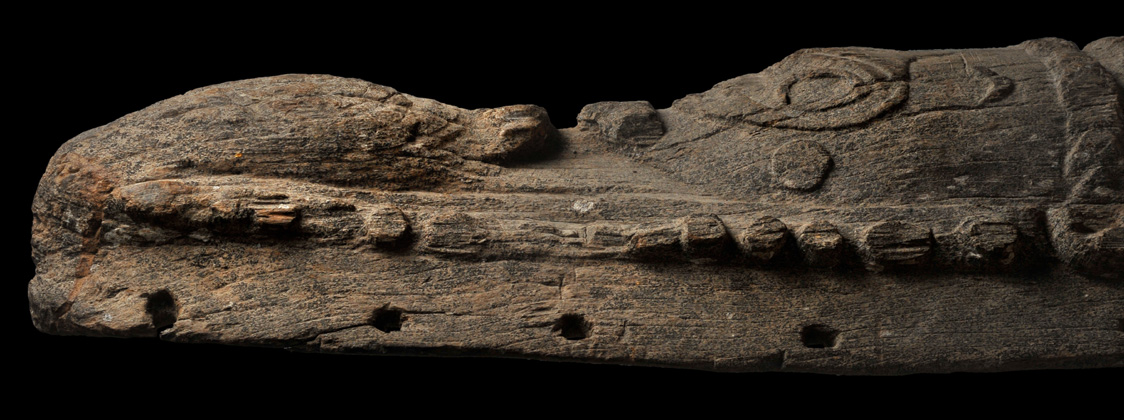DRUMS OF THE WORLD
New Guinea
Yuat River garamut drum New Guinea
Yuat River garamut drum ( Trommel / Tambour ) New Guinea
„Garamut is the Pigin English term for slit-gong, or slit-drum, in Papua New Guinea. It is played only by coastal and river peoples. Garamuts consist of hollowed out logs with a slit along the topsite. Customs sorrounding the playing of the slit-gongs differ from one culture to the next, but usually players hold only one beater and play the instrument either ceremonially or to send a message to villagers out of sight but within a hearing range of the instrument. Large ones may be played by more than one player."
Informations about garamut drums given by Vida Chenoweth in: Musical Instruments of Papua New Guinea 1976
"At Kanduanam the slit gong prows are a complex mix of human and/or animal forms embellishing a central spirit-face (palanggo). I was unable to find out what kind of spirit this is but probably either a bush or water spirit, or possibly a male war spirit like the brag of MurikLakes.( Mangrove Man : Dialogics of Culture in the Sepik Estuary. David Lipset. 1997:135-139)."
Slit gongs are used for musical purposes during ceremonial songs and dances but they are also used to send long distance messages.
Pre-contact, carved with stone tools. L: 251 cm
Die Trommel wurde im Dorf Kanduanum 2 gesammelt. Sie ist mit steinzeitlichen Werkzeugen ( stone carved ) hergestellt worden.
Diese großen garamuts werden als Verkörperung der Ahnen oder Geistwesen angesehen und die auf den Trommeln gespielten Rhythmen als deren Äußerungen. Die Schlitztrommeln werden im Männerhaus aufbewahrt.
Jeder Klan des Männerhauses besitzt eine eigene, mit dem Klannamen benannte garamut, die zu kultischen Zwecken gespielt wird.
Auch die auf der Trommel gespielten Rhythmen sind klanspezifisch und an die Trommel gebunden.
Außerhalb des Kultes werden die Trommeln zur Übermittlung von Nachrichten verwendet (Trommelsignale). Es werden dabei Rhythmen verwendet, die mit den Klantotems in Verbindung stehen.
References:
Burridge, K. (1959) : The slit-gong in Tangu, New Guinea. Ethnos 24.pp.136-150
Chenoweth, Vida (1976) : Musical Instruments of Papua New Guinea
Craig, Barry : Slit Gongs of the Sepik and Madang Provinces.
Craig, Barry (1988) : Art and Decoration of Central New Guinea.
Craig, Barry ; Busse, Mark; Eoe, Soroi;(2010) : Living Spirits with Fixed Abodes - The Masterpieces Exhibition Papua New Guinea National Museum and Art Gallery.
Eberlein, P.J.(1910): Die Trommelsprache auf der Gazellehalbinsel, Neupommern, Antrhopos 5
Fischer, H. (1986) : Sound producing instruments in Oceania.
Leach, J. (2002). Drum and voice : Aesthetics and social process on the Rai Coast of Papua New Guinea. Royal Anthropological Institute.
Lipset, David (1997): Mangrove Man - Dialogics of Culture in the Sepik Estuary.
Penney, David W. (1980): Northern New Guinea Slit-Gong Sculpture. Baessler-Archiv n.F. 38: 347–385.
Sebeok, Thomas A. (1976); Umiker-Sebeok, Donna Jean : Speech Surrogates. Drum and whistle systems.
„Garamut is the Pigin English term for slit-gong, or slit-drum, in Papua New Guinea. It is played only by coastal and river peoples. Garamuts consist of hollowed out logs with a slit along the topsite. Customs sorrounding the playing of the slit-gongs differ from one culture to the next, but usually players hold only one beater and play the instrument either ceremonially or to send a message to villagers out of sight but within a hearing range of the instrument. Large ones may be played by more than one player."
Informations about garamut drums given by Vida Chenoweth in: Musical Instruments of Papua New Guinea 1976
"At Kanduanam the slit gong prows are a complex mix of human and/or animal forms embellishing a central spirit-face (palanggo). I was unable to find out what kind of spirit this is but probably either a bush or water spirit, or possibly a male war spirit like the brag of MurikLakes.( Mangrove Man : Dialogics of Culture in the Sepik Estuary. David Lipset. 1997:135-139)."
Slit gongs are used for musical purposes during ceremonial songs and dances but they are also used to send long distance messages.
Pre-contact, carved with stone tools. L: 251 cm
Die Trommel wurde im Dorf Kanduanum 2 gesammelt. Sie ist mit steinzeitlichen Werkzeugen ( stone carved ) hergestellt worden.
Diese großen garamuts werden als Verkörperung der Ahnen oder Geistwesen angesehen und die auf den Trommeln gespielten Rhythmen als deren Äußerungen. Die Schlitztrommeln werden im Männerhaus aufbewahrt.
Jeder Klan des Männerhauses besitzt eine eigene, mit dem Klannamen benannte garamut, die zu kultischen Zwecken gespielt wird.
Auch die auf der Trommel gespielten Rhythmen sind klanspezifisch und an die Trommel gebunden.
Außerhalb des Kultes werden die Trommeln zur Übermittlung von Nachrichten verwendet (Trommelsignale). Es werden dabei Rhythmen verwendet, die mit den Klantotems in Verbindung stehen.
References:
Burridge, K. (1959) : The slit-gong in Tangu, New Guinea. Ethnos 24.pp.136-150
Chenoweth, Vida (1976) : Musical Instruments of Papua New Guinea
Craig, Barry : Slit Gongs of the Sepik and Madang Provinces.
Craig, Barry (1988) : Art and Decoration of Central New Guinea.
Craig, Barry ; Busse, Mark; Eoe, Soroi;(2010) : Living Spirits with Fixed Abodes - The Masterpieces Exhibition Papua New Guinea National Museum and Art Gallery.
Eberlein, P.J.(1910): Die Trommelsprache auf der Gazellehalbinsel, Neupommern, Antrhopos 5
Fischer, H. (1986) : Sound producing instruments in Oceania.
Leach, J. (2002). Drum and voice : Aesthetics and social process on the Rai Coast of Papua New Guinea. Royal Anthropological Institute.
Lipset, David (1997): Mangrove Man - Dialogics of Culture in the Sepik Estuary.
Penney, David W. (1980): Northern New Guinea Slit-Gong Sculpture. Baessler-Archiv n.F. 38: 347–385.
Sebeok, Thomas A. (1976); Umiker-Sebeok, Donna Jean : Speech Surrogates. Drum and whistle systems.

